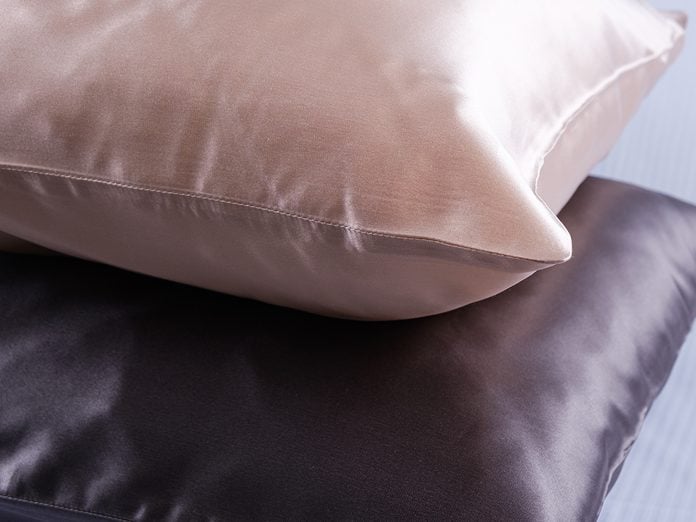Here’s What Dermatologists Really Think About Silk Pillowcases

It's thought that a silk pillowcase can reduce wrinkles, improve your skin, and benefit your hair. But are they worth the cost? Here's what dermatologists have to say about the benefits of silk pillowcases.
Nearly four years after silk pillowcases hit store shelves, many cotton fans have become converts, sure their silk pillowcase has beauty benefits for their skin and hair. Others are happily holding on to their favorite non-silk pillowcases, sleep wrinkles be damned.
A big question—given that silk pillowcases cost between $25 and $90 or more—is do they really help reduce wrinkles, split ends, and frizzy hair? Are they worth it?
In general, dermatologists say there don’t seem to be any downfalls to having one, apart from the steep price tag. There does seem to be truth to the widespread claims of smoother hair and skin after sleeping on silk.
“Our skin is our largest organ, and I believe that any product that can help maintain our skin texture is worth it,” says Orit Markowitz, MD, a dermatologist with SUNY Downstate University in New York City. “I have seen this firsthand with my patients when they come in and point out that they have noticed one side of their face appears more ‘sunken.’ When I ask if it’s the side they sleep on, the answer is yes.”
(Related: 15 Anti-Aging Tips Dermatologists Won’t Tell You for Free)
A smoother snooze, but it won’t solve all skin problems
If you’re ready to make the switch to silk, your skin may benefit.
“It feels nice on the skin. It gives an effect that the skin is ‘slipping’ on the pillowcase,” says Dennis Gross, MD, a New York-based dermatologist. But, he cautions, don’t think that a silk pillowcase will solve skin care woes like aging concerns.
“You should invest in clinical skin care that uses active ingredients like vitamin C, retinol, and alpha and beta hydroxy acids to boost your collagen and elastin production. This will help firm skin so you won’t see pillow lines, no matter what type of pillow you use.”
Still, that pricey nighttime cream will fare better with silk, says Dr. Markowitz. “The fabric absorbs less moisture than cotton, so your skin will stay more hydrated overnight, and your nighttime moisturizer will also stay on your face versus being absorbed by the fabric.”
Less stress on your hair
In the same way that silk doesn’t rob skin of moisture, it likely does the same for natural oils and products in hair. Silk pillowcases can also banish the dreaded bedhead look. With less friction and fewer tangles, silk pillowcase fans say they wake up with less frizz and experience less shedding and breakage over time.
(Related: 7 Dry Hair Tips to Keep Your Locks Happy All Winter Long)
Silk pillowcase benefits
While studies on silk and its effects on skin and hair are scant, a study published in 2019 in the journal Dermatology Reports found that wearing silk “underclothes” for one month proved effective in treating atopic dermatitis, or eczema, by calming the red, itchy rashes that are characteristic of the condition.
“Inflammatory skin diseases like atopic dermatitis and psoriasis tend to flare up when they encounter rough materials like a cotton pillowcase,” says Dr. Markowitz. “Therefore, using a light material like silk will be especially beneficial for these skin types because it won’t irritate the skin when you’re sleeping.”
Dr. Markowitz also notes that silk may provide an antimicrobial effect. “Antimicrobials have also been found in silk textiles, making a case that people with acne and atopic dermatitis would benefit from a silk pillowcase,” she says. “Antimicrobials are an agent that kill microorganisms like bacteria and is helpful in the healing of comprised skin.”
(Related: Is It Eczema or Something Else? 5 Clear Signs to Never Ignore)
How to choose a good silk pillowcase
Not all silk pillowcases are created equal. If you want a good buy, you’ll have to read the fine print. Silk is measured in momme weight, which is the standard unit to measure weight and quality. It’s similar to thread count in sheets.
“The higher the momme weight, the better, as this means a greater amount of silk was used during the weaving process,” explains Dr. Markowitz. “A good rule of thumb when shopping for a pillowcase is to select a momme weight in the high teens or low 20s. Anything super low is not as durable and is more prone to tearing.”
But Dr. Gross says it’s hard to go wrong with your choice. “There is not a huge difference between pillowcases,” he says. “My recommendation is to select one you like and can maintain.”
How to clean a silk pillowcase
No matter which kind of pillowcase you prefer, proper hygiene is a must for skin health. “Pillowcases should be washed regularly—about two times per week—in order to avoid bacteria buildup, which leads to acne,” says Dr. Gross. “This is important to consider when selecting a pillowcase because most silk pillowcases need to be hand washed or machine washed separately on gentle cycle.”
If that sounds like way too much work, then skip silk and choose cotton. “Cotton pillowcases are more low maintenance,” says Dr. Gross.
Next: A Decade-by-Decade Guide to Changing Up Your Skin Care Routine




